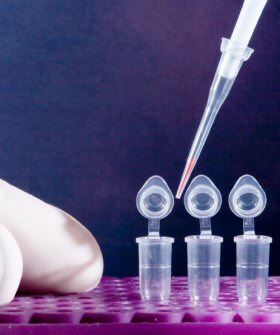23 March 2008
First Analysis Of Hominoid-Only TBC1D3 Gene
by Kate Melville
 Human DNA contains approximately 23,000 genes but only around 50 - 100 are unique to man. Even including our immediate neighbors on the tree of life - the primate family known as hominoids - may yield only several hundred unique genes. But despite the unique and important roles these genes likely make to our species, little is known about them. Now, scientists at Washington University School of Medicine have produced the first detailed analysis of the cellular functions of a hominoid-only gene, TBC1D3. They affirmed earlier evidence linking the gene to cancer, showing that TBC1D3's protein can keep cellular growth factors active and helps turn on RAS, a protein that is active in a third of all human cancers.
Human DNA contains approximately 23,000 genes but only around 50 - 100 are unique to man. Even including our immediate neighbors on the tree of life - the primate family known as hominoids - may yield only several hundred unique genes. But despite the unique and important roles these genes likely make to our species, little is known about them. Now, scientists at Washington University School of Medicine have produced the first detailed analysis of the cellular functions of a hominoid-only gene, TBC1D3. They affirmed earlier evidence linking the gene to cancer, showing that TBC1D3's protein can keep cellular growth factors active and helps turn on RAS, a protein that is active in a third of all human cancers.
"I was astounded at how little attention has been given to human-specific genes, which make us what we are and could potentially offer a great deal of insight into human physiology," said senior researcher Philip D. Stahl. "In addition, certain pathogens, such as the malaria parasite, have human specific-components in their infection cycle. Human-only genes could offer us unique insights into how the parasites take advantage of us and possibly provide potent new avenues for fighting back."
Stahl said that TBC1D3 was originally identified as a likely contributor to breast cancer. At the time of its discovery, other researchers linked its protein to endocytosis, a process cells use to take in material from their surface.
Stahl's group studies endocytosis and how growth factor receptors, proteins important for both normal and cancerous growth, are turned on and off. Found on the surfaces of cells, growth factor receptors turn on when they bind to a growth factor protein. To turn them off, cells take in the combined receptor-protein through endocytosis and put it through a number of different processes before finally breaking down the growth factor receptor.
When Stahl and colleagues determined in 2006 that the TBC1D3 gene is only found in hominoids, their curiosity was piqued. Evolution, Stahl notes, naturally tends to retain genes involved in the most important components of metabolism. If one of these genes mutated too dramatically, that would lead to an organism so sickly that it wouldn't survive long enough to perpetuate the mutation in its descendants. So evolution "conserves" these genes, retaining them largely unchanged as one species evolves into another.
Therefore, if the genome is compared to an automobile, human-only genes are unlikely to be adding new wheels. But they could, for example, be contributing a new anti-lock braking system: a regulatory function that fine-tunes essential processes originally established millennia ago in other species. Stahl found evidence that this is the case in TBC1D3. Human DNA has eight copies or paralogs of the TBC1D3 gene. His lab showed that the increased levels of the protein made by one of the paralogs makes human cells grow more rapidly. When they transplanted the gene for the protein into mouse cells, it had the same effect.
A closer look showed that the protein from the TBC1D3 paralog delays a process that labels growth factor receptors for breakdown, prolonging the time that their signal is active. He also found evidence that the protein was helping to activate RAS, another gene whose protein is commonly found in human cancers.
According to the report in The Journal of Biological Chemistry, Stahl plans additional research to learn whether the other paralogs of TBC1D3 have different roles. He also has several ideas for learning more about the functions of human-only genes. "We might try an organ-by-organ approach, looking to see if any genes specific to a particular organs, such as fat, are specific to humans," he says. "We also should probably look at crystallizing the proteins from some of these genes, which can tell us more about what they interact with."
There may be human diseases where these genes are mutated or missing, Stahl speculates. The effects of such conditions could provide important clues to what the humans-only genes do. "It's also going to be very interesting for evolutionary biologists to try to develop a sense for where these humans-only genes come from," Stahl concluded. "The building blocks of these genes may be present but not active in earlier species."
Related:
"Language" Gene Pooh-Poohed
Genome Analysis Left Wanting
Horizontal Gene Transfer Vastly Underestimated, Suggests New Study
Source: Washington University School of Medicine
